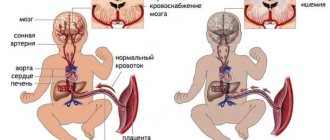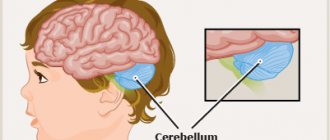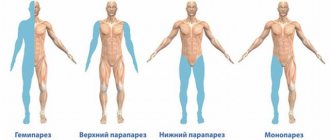Dyscalculia is a specific impairment of the ability to learn arithmetic, usually manifesting itself in preschool and primary school age. In fact, the disease is a whole complex of disorders that affect the logical aspects of understanding arithmetic operations, the laws of number conversion, etc. In most cases, the disorder acts as an independent pathology, not being a symptom of any underlying disease. Children with dyscalculia often also have attention deficit disorder.
In adults, this disease may indicate organic brain damage. Often, disorders of this kind occur with strokes, tumors, traumatic brain injuries, and cysts in the temporal lobe of the cerebral cortex.
How to identify dyscalculia?
Symptoms of dyscalculia may look different depending on age and stage of development. Common symptoms of dyscalculia include:
- difficulty understanding or remembering math concepts such as multiplication, division, fractions, etc.;
- difficulty understanding verbal or written cues (such as the word "two") and their mathematical symbols and notations (the number 2);
- problems with explaining mathematical processes;
- difficulty describing a sequence of events or remembering steps in a mathematical process.
Classification
In clinical practice, a classification of dyscalculia is used, according to which the disease is divided into the following types:
| View | Characteristic |
| Practognostic | Manifests itself in difficulties when counting objects |
| Dyslexic | characterized by the inability to correctly read symbols used in arithmetic |
| Verbal | Difficulties in verbally naming mathematical terms and notations |
| Graphic | Difficulties in the process of writing numbers and arithmetic symbols, difficulties when it is necessary to graphically reproduce geometric shapes |
| Operating room | Difficulties that arise when performing various mathematical operations |
What causes dyscalculia?
Some researchers believe that dyscalculia is the result of a lack of early math instruction.
A child who has never been taught to count with an abacus, or who has never had multiplication using objects that increase in material quantities, is more likely to develop dyscalculia.
Important! Dyscalculia can occur on its own or along with other developmental delays and neurological conditions.
Children and adults may be more likely to be diagnosed with dyscalculia if they have:
- dyslexia;
- attention deficit hyperactivity disorder;
- depression;
- anxiety.
Dyscalculia may also have a hereditary component. For example, if you grew up with a mother who regularly told you that she was simply "useless" at math and, as a result, couldn't help you learn math, chances are you'll struggle to understand math, too.
Excerpt describing Dyscalculia
The rain passed, only fog and drops of water fell from tree branches. Denisov, Esaul and Petya silently rode behind a man in a cap, who, lightly and silently stepping with his bast-clad feet on roots and wet leaves, led them to the edge of the forest. Coming out onto the road, the man paused, looked around and headed towards the thinning wall of trees. At a large oak tree that had not yet shed its leaves, he stopped and mysteriously beckoned to him with his hand. Denisov and Petya drove up to him. From the place where the man stopped, the French were visible. Now, behind the forest, a spring field ran down a semi-hillock. To the right, across a steep ravine, a small village and a manor house with collapsed roofs could be seen. In this village and in the manor's house, and throughout the hillock, in the garden, at the wells and pond, and along the entire road up the mountain from the bridge to the village, no more than two hundred fathoms away, crowds of people were visible in the fluctuating fog. Their non-Russian screams at the horses in the carts struggling up the mountain and calls to each other were clearly heard. “Give the prisoner here,” Denisop said quietly, not taking his eyes off the French. The Cossack got off his horse, took the boy off and walked up to Denisov with him. Denisov, pointing to the French, asked what kind of troops they were. The boy, putting his chilled hands in his pockets and raising his eyebrows, looked at Denisov in fear and, despite the visible desire to say everything he knew, was confused in his answers and only confirmed what Denisov was asking. Denisov, frowning, turned away from him and turned to the esaul, telling him his thoughts. Petya, turning his head with quick movements, looked back at the drummer, then at Denisov, then at the esaul, then at the French in the village and on the road, trying not to miss anything important.
Diagnostics
Dyscalculia is diagnosed in several stages.
First, the doctor will take information about your medical and family history. These questions are designed to rule out other possible diagnoses and ensure there is no urgent physical condition that needs to be addressed.
In the next step, adults may be referred to a psychologist and children to a team of learning specialists , including a psychologist and a special education specialist. They will do further testing to see if a diagnosis of dyscalculia makes sense.
History of basic concepts
Although the term "acalculia" was only introduced in 1919, the description of the counting center was made more than a century earlier by the Swiss neuroanatomist Gall and his assistant Spurzheim.
However, according to their description, it was localized in the frontal lobe in the orbitofrontal region and was directly related to the area of expressive speech. Counting disorders were considered as disorders directly related to motor aphasia. Only in 1926, the German physiologist and psychiatrist Hans Berger proposed to distinguish primary acalculia, when the skill of mathematical operations is lost in isolation due to damage to the center of calculation (in the parietal-temporo-occipital region), and secondary, arising as a result of suffering from other higher cortical functions (for example, with digital alexia - inability to read numbers).
Complete loss of counting skills is quite rare. Therefore, they often resort to the term “dyscalculia,” which is understood as a partial loss of the ability to count. As a rule, dyscalculia is diagnosed in children.
Etiology
A large number of cognitive systems are involved in the counting function. Pathology of any of them can lead to the development of acalculia. The most common causes of loss of counting skills are:
- cerebrovascular diseases;
- traumatic brain injuries;
- brain tumors;
- infectious diseases of the brain;
- chronic and acute intoxication;
- some hereditary syndromes (for example, genetically determined dementias).
These same factors can act as a cause of dyscalculia.
Such violations often lead to a partial loss of the ability to perform arithmetic operations. As a rule, the child in this case has a combination of this pathology with various types of developmental disorders (speech, motor, mental).
Classification
The classification of acalculia is quite arbitrary. As a rule, disorders of several cognitive systems lead to the development of such pathology. Therefore, acalculia will be an expected element in aphasia, alexia and agraphia. Due to the predominant damage to one of the cognitive functions, the following types of acalculia are distinguished:
- Verbal. At the same time, the verbal designation of mathematical concepts suffers. Counting operations are performed successfully, but the patient is unable to name numbers, symbols, quantities.
- Apraxic. Manifests itself in the form of a violation of the number system of specific and visual objects or their symbols. Patients are unable to count objects or divide them according to quantitative characteristics.
- Dyslexic. The primary disorder observed is reading mathematical symbols (numbers, signs), verbal expressions of quantitative terms;
- Graphic. The skill of recording mathematical signs, symbols and correct reproduction of geometric figures suffers.
- Operating room. Associated with loss of ability to perform mathematical operations.
There is another classification, according to which the pathology can be divided into specific (primary acalculia) and nonspecific (secondary form).
Nonspecific forms include acalculia:
- Optical. It occurs when the occipital lobes of the hemisphere, which is the cortical representation of the visual analyzer, are damaged. The optical perception of numbers or mathematical symbols suffers. Patients cannot recognize and evaluate arithmetic symbols that are similar in design; there is often a defect in the assessment of numbers indicated by Roman numerals;
- Sensory. Acoustic speech perception is primarily affected. Oral counting and counting operations performed by ear are impaired;
- Acoustic-mnestic. In this form, the acoustic perception of speech is also impaired, but it is associated with a violation of auditory-speech memory and the volume of auditory perception.
Representatives of a specific form are the frontal and parietal (or parieto-occipital) subtypes.
Frontal acalculia is associated with a violation of the basic functions of the frontal lobe - programming, regulation and control of the course of all human mental functions. Pathological processes affecting the frontal lobe lead to disruption of all higher forms of organization of conscious activity, including counting.
Parietal (or parieto-occipital) acalculia occurs when the corresponding areas of the brain where the primary counting center is located are damaged. It is formed on the basis of already formed and normally functioning visual, auditory, vestibular and skin-kinesthetic analyzers. As a rule, this occurs by 7 years of age.
According to various sources, approximately 5-6 percent of primary school students have difficulty with counting operations. These statistics cannot claim complete objectivity, since the diagnosis of dyscalculia is made only in some cases. In most situations, parents are not inclined to associate the fact that a child does not count well with any deviation. As a rule, such a child is defined as a “humanist” and concentrated on his abilities in other sciences.
Psychologists advise paying attention to the first signs of dyscalculia when a child is 5-6 years old. It is during this age period that the child begins to actively learn and become familiar with numerical symbols and the actions performed with them.
- Graphic dyscalculia. A person has difficulty writing numbers and other symbols. In the same case, difficulties in perceiving geometric shapes are observed.
- Practognostic. Abstract mathematical concepts cannot be translated into real-life examples. As a result, the perception of arithmetic calculations deteriorates and the person experiences difficulties in applying them in practice.
- Lexical. The child can absorb information about rules and numbers from teachers or parents, but cannot study independently because he cannot comprehend mathematical signs through reading.
- Verbal. Numbers and mathematical concepts are not perceived or are not well understood by ear. At the same time, the ability to complete written tasks is preserved.
Certain types of dyscalculia can be combined with each other, making diagnosis and subsequent treatment difficult.
Treatment
Dyscalculia can be managed with treatment strategies. If left untreated, dyscalculia in adults can lead to difficulties at work and financial problems. Luckily, there are strategies for children and adults.
For children
The specialist can suggest treatment options for your child at school and at home. These may include:
- repeated practice of basic math concepts such as counting and addition;
- segmenting topic material into smaller units to make information easier to digest;
- using small groups of other children to teach mathematics;
- Revisit basic math concepts in practical, tangible demonstrations.
Important! The literature on the treatment of dyscalculia has noted that the success rates of strategies recommended for the treatment of dyscalculia are not well documented. The best treatment plan will take into account the child's individual talents, needs and interests.
For adults
Treating dyscalculia in adults can be more challenging if you are not in a learning environment with specialized educational resources available.
Exercises and learning materials will help you strengthen the neural pathways used in mathematics . Training or private lessons can help treat dyscalculation in adults as well as dyslexia in adults.
Symptoms
Signs of unstable behavior due to pedagogical neglect and social disadvantage are often observed. In most cases, along with dyscalculia, dysgraphia (problem of spelling and poor handwriting) is noted. But a child can write and read quite well.
Let us indicate some difficulties that are signs of specific dyscalculia :
- Misunderstanding what a number means, what its bit structure is.
- Lack of understanding of how numbers are connected and what their internal structure is.
- Misunderstanding what zero means, the left and right components of a number.
- Inability to build automated digital and ordinal series.
- Inability to add numbers past ten, subtract, divide and multiply.
- Inability to recognize number signs.
- Inability to relate numbers when performing arithmetic.
- It's difficult to learn the multiplication tables.
- Inability to solve problems that require understanding the meaning and carrying out two or more logical operations and the need to keep certain actions in memory.
- Lack of understanding of the mathematical content of diagrams and pictures that contribute to the correct solution.
- Inability to perform logical-abstract operations in the fields of algebra, geometry, trigonometry, and physics.
In other words, the child can easily count within ten, but does not operate with larger numbers. He is not able to understand the structure of numbers, to correlate the number and its spelling using numbers. Therefore, a child often has difficulty learning to tell time, practically does not remember dates, phone numbers, formulas, and at school cannot keep up with drawing, physics, and chemistry. If these symptoms appear, do not delay solving the problem.
Without the skills and abilities that mathematics provides, it is difficult to perform many basic daily functions. In addition, mathematics is one of the main subjects of many higher and secondary vocational educational institutions, which will be almost impossible for a child with dyscalculia to enroll in. A gradually developing fear of mathematics, generated by regular failures in class, can create many problems for a student.
What is the outlook for people with dyscalculia?
Dyscalculia is treatable , and early diagnosis can make a big difference in how a person who has it learns math. People with dyscalculia may find it more difficult to learn math concepts, but it is by no means impossible.
Dyscalculia refers to a learning disability that makes learning mathematical concepts difficult . People with dyscalculation may need to take a different approach to learning math concepts, moving more slowly when they encounter new material.
Dyscalculia - inability to do arithmetic
The ability to count seemed to be a fundamental skill without which it was impossible to live, get an education and master a profession. But difficulties with arithmetic were recorded as a disorder - dyscalculia. A recent issue of Science published an article by three British professors who insist that this disorder is extremely serious, look for its causes in the cerebral cortex and convincingly ask that school curricula be restructured so that people with dyscalculia can also learn to count.
I asked one of the authors, Brian Butterworth, if it was possible to identify the main symptom of dyscalculia. He replied: “It is the inability to understand numbers when one can be good at other areas of mathematics, such as geometry.” A person with dyscalculia begins to bend their fingers when adding or subtracting, even if they have long since passed childhood. He cannot roughly estimate the result of a simple arithmetic operation, compare two numbers or count from 10 to 1. When asked to count in tens, a series can easily look like this: 70, 80, 90, 100, 200, 300...
There are as many people with this disorder as with dyslexia - 5-7% of the population. But since dyscalculia has been studied much less well, it means that people with this disorder often turn out to be inferior members of society. As a result, this feature greatly affects the social status of its carriers: according to statistics, they earn and spend less, they are more likely to have problems with the law and they get sick more often.
There will always be children who are successful in arithmetic, and, conversely, those for whom the most primitive examples cause horror. I have a family friend who hired not just a math tutor for their son, but a psychoneurologist. She came with a strange device to measure reaction speed, coordination of movements and other features of the brain, and only after diagnostics did she begin mathematics. In another family, a first-grader son, on the contrary, brilliantly solved problems for the eighth grade, but wrote dictations in the language of “bastards.” Did the first one have dyscalculia and the second one have dysgraphia? Grandmothers and teachers in both cases were inclined to the archaic version: “mother laziness”, “I haven’t tried the belt for a long time.” But no pedagogical conclusions were made - mathematics and Russian were taught using old methods.
So far, neither parents, nor teachers, nor even scientists fully understand what kind of disorder dyscalculia is and how to eliminate it. Brian Butterworth recommends using the formal Dyscalculia Screener test to help distinguish overt forms of dyscalculia. An article in Science describes existing correction methods: the authors believe that children with dyscalculia should be assigned a special course that will not just chew on the standard set of knowledge, but will be structured in a fundamentally different way. Since children with this disorder do not have any image behind abstract numbers, the simplest and most effective way is to teach them to associate an abstract number with a visual image. Demonstrate graphically how three differs from two and four, reinforcing this knowledge through interactive play.
Scientists estimate that learning to cope with dyscalculia has a significant impact on the economy, which suffers a significant loss of £2.4 billion each year. But I’m wondering what skill will be next on the list of “disorders” - after all, a new disease cannot but arise, in which we will joyfully recognize our own diagnosis.
Reasons for violation
Acalculia occurs due to damage to the parietal, occipital, temporal and prefrontal parts of the cerebral cortex. The causes of such brain damage can be different:
- a significant number of neurological disorders in the perinatal period
- hereditary factor;
- organic brain lesions;
- neuroinfections;
- neoplasms in the brain;
- various intoxications;
- dysmetabolic abnormalities;
- brain damage due to infectious diseases;
- negative social environment;
- cerebrovascular diseases;
- traumatic brain injuries.
Implications and Limitations
Acalculia can cause various complications. Such negative consequences include agrammatism (difficulties in composing and perceiving sentences), paraphasia (replacement of sounds, incorrect use of sounds), speech embolus (obsessive repetition of a word or phrase).
The consequences of acalculia also include a decrease in an individual’s social adaptation due to a combination of the disease with other cognitive impairments. As a result, the patient's quality of life decreases.
When the disease develops in children, this causes problems in learning, social adaptation at school, impairs communication skills and can negatively affect the child’s further cognitive development. Children may develop low self-esteem and depression.











